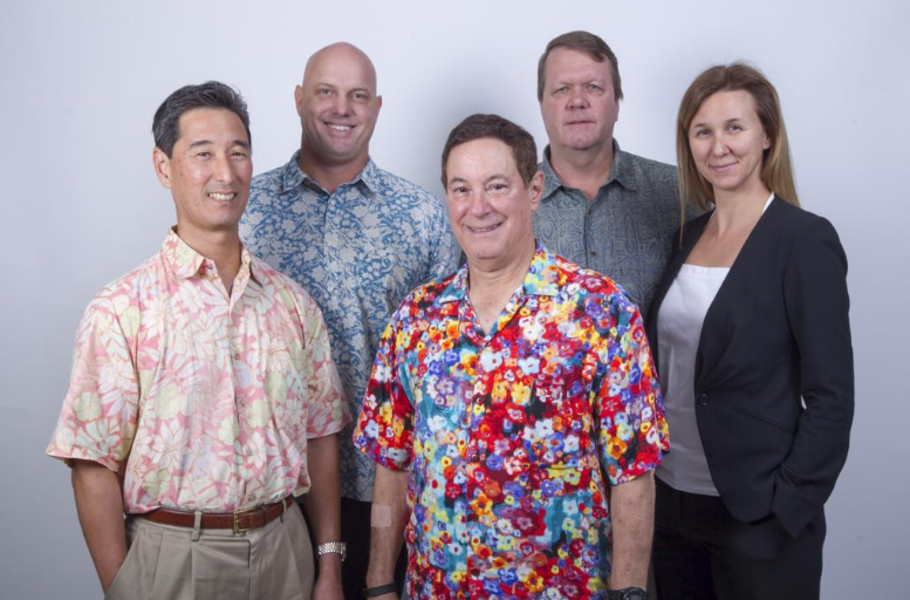There are record numbers of tourists coming to Hawaii, but retailers are not seeing record sales. Landlords have been adjusting to a new landscape of lower rents and shorter leases, and medical uses are showing up in more shopping centers.
Those are some of the trends in the retail real estate market that dominated the discussion during PBN’s 2018 commercial real estate roundtable.
Brooks Borror, principal broker and managing partner of Commercial Consultants Inc.; Jessika Fodor, principal of JFodor & Co.; Mike Hamasu, research and consulting director at Colliers International Hawaii; Steve Sofos, president and CEO of Sofos Realty Corp.; and Andrew Starn, senior vice president and retail market expert at Cushman & Wakefield ChaneyBrooks, offered their expertise on what’s shaping today’s market.
Tourists are coming, but not shopping
Jessika Fodor, whose firm is based in Waikiki and focuses on the resort market, noted that despite record numbers of visitors over the past year, “we haven’t seen that translate into sales in the same way that they used to, and we’re not 100 percent sure why.”
Foot traffic isn’t translating to sales the way it used to, she said.
“What we’ve noticed is a lot of movement in relocations, downsizing, rightsizing people’s businesses to try to react to what they’re seeing on their customers or lack thereof,” she said.
The Hawaii Tourism Authority reported that per person, per day spending for all of 2017 was $199.70, and that number rose to $209.80 in January. But Fodor questions those numbers.
“I’ve called the state, I’ve asked them how they collect that data,” she said. “It’s by survey, it’s not by credit card data, which would be, I think, more precise.”
Steve Sofos noted that hotel rates have risen, too.
The HTA reported in January that the statewide average daily rate rose 4.1 percent last year to a record $265, while on Oahu, that figure rose 2.5 percent to $233.
That means visitors who budget a certain amount to spend on their vacations are allocating more of that budget to hotels and less to shopping.
“Everyone has the pie they’re going to spend in their currency,” said Andrew Starn. “The two factors are the strong dollar, which means there’s less overall U.S. dollars spent, which, when you’re counting in U.S. dollars has an impact and then the hotels that are at all-time ADRs, and that’s taking up more of the pie.”
Starn also noted that visitors are spending more on dining out and other experiences, rather than stocking up on clothing and accessories.
“The good news for Hawaii is that compared to a lot of the other gateway markets, we’re much healthier,” he said. “So while we’re sitting here in Hawaii and going ‘things are difficult,’ if we were in New York City there’s all this shadow space on Fifth Avenue, or even San Francisco — we’re just really fortunate to have such a diverse tourist market that everyone tends to prop things up.”
Higher vacancies, lower rents, shorter leases
Trends in vacancies and rents tend to go from east to west, so the higher vacancy and lower rent numbers being seen in New York are making their way to the West Coast, and eventually Hawaii, Fodor said.
“They had huge vacancies on Fifth Avenue and those landlords have started to come to terms with that and started to drop their prices,” she said. “The landlords are always sort of backwards-looking and the retailers are forward-looking.”
But the increased vacancy will create opportunities, and those businesses “who’ve got the skills, who know how to sell what somebody wants to buy will have an opportunity to slip into some maybe otherwise unavailable real estate in the past in good locations,” Fodor said.
Starn noted that some new retail leases are changing from traditional 10- or 20-year terms to much shorter terms of five years or less, and similar terms are being negotiated for renewals.
“I think that the tenants are going to be demanding shorter terms so they have more optionality at the end of their leases, that’s going to be a big shift,” he said.
Fodor has one national retail client that has stores in Ala Moana Center and Waikiki and is looking to do seasonal stores in other resort markets around the state.
“Like a four-month lease, and if we do well, we’ll exercise for another four option,” she said. “This is a national credit tenant who’s in the top five per-square-foot sales in the country.”
The retailer is looking at “second-generation spaces that are in decent shape” and is also looking to fill gaps for spaces that are in lengthy negotiations with long-term tenants.
“There’s going to be a lot of that, and a lot of temporary long-term [leases],” Starn said. “That’s a major shift coming, and I think landlords are going to be very difficult to get used to that.”
And rents are not what they used to be.
Brooks Borror, whose firm represents several Waikiki properties in addition to grocery-anchored neighborhood centers, said that recently, “we’re actually having to discount rent from previous tenant rent by about a third, so I haven’t seen that in the neighborhood centers.”
“That’s a reverse trend where you see the daily needs neighborhood centers appreciate in the rents, but the Waikiki rents seem to be going the other direction,” he said.
Sofos noted that some large property owners such as Alexander & Baldwin are “trying to dominate the retail market.”
“The market’s here and they’re up here and they’re trying to force everybody,” he said. “So you’re going to see a lot of vacancies as those tenants have a hard time.”
Fodor agreed, saying “some landlords are trying to get rent increases, shockingly so, they’re still asking for top dollar rents as if we were in the same market [from] four years ago today.”
“Those tenants are going to leave those properties and hopefully they find somebody like us who says let us take you to someone who is reasonable, let us take you to a place where you can make money, and take you to a property where the landlord acknowledges the reality of the circumstances today and is willing to do a deal that both of you can pay a mortgage on,” she said.
GGP, which owns and manages the state’s largest shopping mall, Ala Moana Center, has been reaching out to the brokerage community over the last year as vacancies at the mall have increased since the opening of the Ewa wing two years ago.
“I would say they’re remarkably accommodating today, Ala Moana,” Starn said. “They’re another one of the national companies that’s looking at trends going across the United States.”
Fodor agreed that GGP has been more accommodating to tenants.
“In the last six to 12 months, they’ve been more flexible than the last 17 years,” she said. This week, GGP announced it was being acquired by Brookfield Property Partners LP.
Some landlords have also been more flexible on tenant-improvement allowances.
Fodor, whose client, Down to Earth, has signed leases for three new stores in Kakaako, Kailua and Pearlridge Center that are currently being built out, said that landlords who understand “that this tenant is not going anywhere, those are the landlords who are going to get a Down to Earth deal and contribute to the TI allowance.”
Airbnb and the internet
Hamasu noted that the vacancy rate for Waikiki — which was 12.69 percent at the end of 2017, according to the Colliers International Hawaii year-end report — is fairly high for that market.
“A lot of that has to do with International Market Place,” he said. He also questioned whether some of the softness in the Waikiki market was due to visitors staying in vacation rentals instead of hotels.
“I think that would be true, except if you figure the hotels, 10 percent of the vacancy is always out of stock for construction and remodels,” Starn said. “They’re basically 100 percent occupied.”
Hamasu also noted that a number of budget and mid-level hotels in Waikiki have been redeveloped into luxury properties “and you’re still keeping 100 percent occupancy.”
“You have this market that’s relocating outside Waikiki and still spends money,” he said.
Fodor noted that currency rates have shifted over the past six years to the point that it’s costing people 30 percent, 40 percent more to shop here than it did,” she said. “And a large part of our visitors is the repeat visitor, so they remember what it used to cost when they came on their vacation two or three times ago.”
And with hotels nearing full occupancy, the hotels are “not necessarily opposed to vacation rentals.”
“Our whole economy would suffer if we didn’t have those visitors in our neighborhood shopping centers, which probably never had tourist dollars buying groceries, but they do now,” she said.
Internet sales present an opportunity for local retailers, Starn said.
“The opportunity for retailers today is to make that commerce omni-channel store experience really a great one,” Starn said. “If you can buy something online and take it back to the store when it doesn’t fit, and they just say ‘this is one of our shirts’ and take it.”
He noted that brands such as Patagonia, which has stores in Haleiwa and Kakaako, where it also bought a building, make it easy for customers to buy online and return in stores, which creates “huge customer loyalty.”
“It makes it more important to have street stores,” Starn said. “Then someone gets to really feel the brand and identify the brand.”
Food, fun, fitness
Borror noted that much of the retail industry is evolving toward experiences, dining and entertainment, which can be traffic generators for shopping centers and malls. Ka Makana Alii has Fun Factory and Johnny Rockets, and Ala Moana Center replaced the old Shirokiya store with Lucky Strike Social and other restaurants, and leased a portion of the old Nordstrom store to a gym.
“Planet Fitness went into the regional mall, that’s unheard of,” Borror said. “There’s a real evolution.
“Malls and retail, be it Kalakaua [Avenue]or neighborhood centers, have to provide an alternative to what you can get online. If you can get it online, you’ll probably get it online and it will be faster and cheaper, if you can’t, you’ll probably go to experience” at the malls, he said.
On Maui, where Borror’s firm was handling leasing for the Target-anchored Puunene Shopping Center, people in the community had asked for a bowling alley, he said. The owners ended up putting in a 25,000-square-foot trampoline park, “and people were lined up before they opened.”
Medical use and vacant big-box stores
Hamasu noted that dialysis centers and health care-related entities are taking spaces in shopping centers, such as U.S. Renal Care, which took over the Simply Organized store space at the Kapolei Crossroads shopping center.
“That’s the only positive thing that came out of Obamacare is the urgent care [centers],” Sofos said. “They’ve been doing phenomenal, they average around 2,500 to 5,000 feet. That’s going to be something you’ll see keep continuing.”
Sofos’ firm is handling leasing and sales for a project in Kapolei that will have 300 affordable rental and condominium residential units and 32,000 square feet of commercial space on the ground floor.
“What’s been surprising … we’ve had so much activity from the medical industry — dentists, doctors, specialists,” he said. “The theme is the same thing — we want to own our own location for the next 20 years until we retire and then sell it.
“That’s good to see something like that happening,” he said. “I was quite surprised that there were so many wanting [space].”
Starn said medical use is the “sole good news” for the office market, which has lagged behind retail and industrial in Hawaii. Doctors and other medical-use buyers are also able to finance their improvements, including pricey equipment.
“Ninety percent of the sales we’ve done in the three years have all been owner-users and they’ve all benefited from the Hedco loans,” said Sofos, referring to loans backed by the U.S. Small Business Administration for capital expenditures including real estate and equipment. “They fund 40 percent and the bank funds the other differential so you have 90 percent financing — they’ll include all your interior improvements on the property.”
The group’s discussion took place a week before Toys “R” Us announced it would close all of its U.S. stores, including four in Hawaii. Two of those stores are big-box spaces — a Babies “R” Us anchor store in the Pearl City Gateway shopping center and a freestanding building at Pearlridge Center.
Those add to a market that has already seen chains such as Kmart and Sports Authority close a large number of stores around the Islands.
Sofos’ client Costco, which has six stores in Hawaii, has been offered shuttered big-box spaces in shopping malls on the Mainland.
But Starn said replacements for big-box spaces here in Hawaii are “virtually nonexistent.”
“Reformatting, except for the very best spaces, it’s going to be very difficult,” he said.






